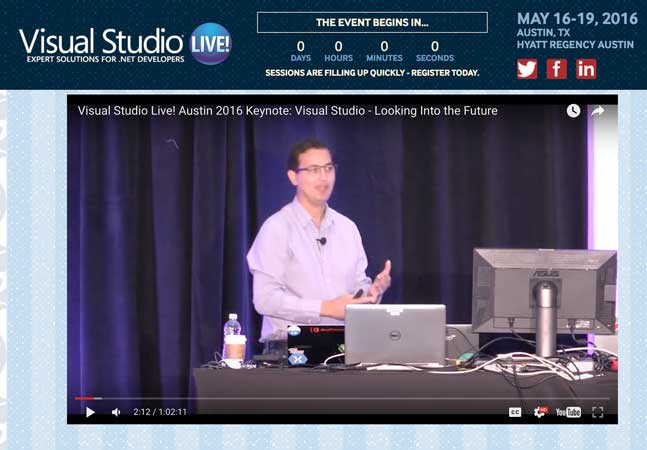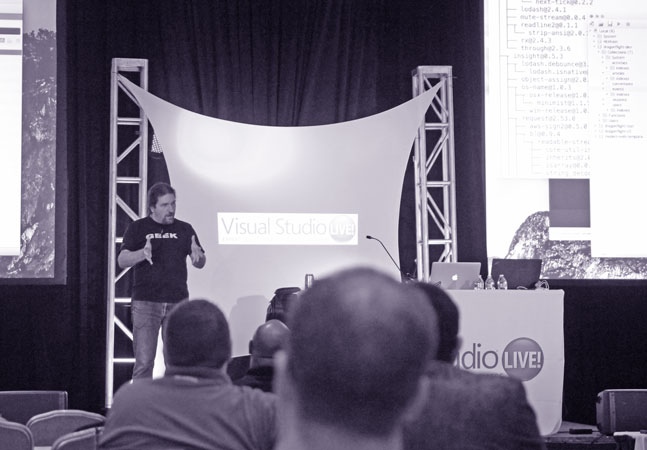
From Visual Studio Live! Austin: Innovations like Microsoft's HoloLens will require adapting procedural, linear programming and thinking in terms of compositional programming, observes UX expert Billy Hollis.

From Visual Studio Live! Austin: Microsoft's Tarek Madkour reveals the current state of the Visual Studio union, with a good view of the latest on .NET and .NET Core.

What you can do with most programming languages can be accomplished in F#'s functional programming paradigm. Here's how to handle some simple operations, which might look familiar to you already.
- By Arnaldo Pérez Castaño
- 04/20/2016

It's time to take a break. Have you seen Silicon Valley? It's a comedy, but the depiction of a developer startup hits very close to the bone.
- By Wallace McClure
- 04/19/2016

An MVP is not some Microsoft award, but the acronym for a term, "minimum viable product," that loosely defines what you're trying to provide as far as features -- at a bare minimum -- to get your app to market. Let's look at the considerations for making sure your app achieves MVP status.
- By Wallace McClure
- 03/22/2016

It's iOS and Android, then all others, along with Windows Phone. But some reports believe Windows Phone is the real growth market, and developers should take heed since there's money to be made there.

We looked at the basic features of functional programming with Visual F#. In this second part, we take it a bit farther and look at creating anonymous functions, pattern matching, and other features of F#.
- By Arnaldo Pérez Castaño
- 02/16/2016

The functional programming paradigm, which has been around for decades, has never gone out of style. In this two-part series, we look at Microsoft's implementation, Visual F#.
- By Arnaldo Pérez Castaño
- 02/10/2016

You're a developer who's managed to create the killer app. You've also built a well-rounded team and marketing plan to push it. But wait -- is it what users want?
- By Wallace McClure
- 01/06/2016

True artificial intelligence is years away. But we can demonstrate the challenges of AI decisionmaking using C# to derive solutions for the classic sliding tiles puzzle.
- By Arnaldo Pérez Castaño
- 10/30/2015

The trie data structure is one alternative method for searching text that can be more efficient than traditional search approaches. Here's a trie class you can create in C#.
- By Arnaldo Pérez Castaño
- 10/20/2015

Organizations that encountered security breaches have lost large sums of money, both directly and indirectly in terms of damaged reputations, layoffs, fines, etc. With so much at stake, developers need to turn to IT security, which is now a must for any IT department.

Now that we've got the basics of microservices, what happens when we take into production? It's time to make sure your message reaches its intended targets.

What's all the hubbub with microservices? The benefits are in application management and delivery. Paul Mooney shows how in this sample C# app.

Microsoft's Brian Harry offers a look deep inside the evolution of the company's development operations as it transformed itself into a cloud-centric organization.

SharePoint is versatile, in that developers can interact with its data via other programming languages besides what's in Visual Studio. Here's how AngularJS fits into the development mix.
- By Malin De Silva
- 09/29/2015

You're a smart developer and so it's possible to do everything yourself. But your chance of success improves if you build a team to help you get your app to market. Here's why.
- By Wallace McClure
- 08/27/2015

The Open Data Protocol allows for creation and consumption of REST APIs. Sam Nasr demonstrates OData 4 in a sample app that demonstrates containment, a new feature for facilitating data access.

Asynchronous services are easier to implement with support of the await and async keywords in WCF 4.5. We look at that, as well as contract-first development.
- By Joydip Kanjilal
- 08/05/2015

We catch up with the MSDN magazine columnist on remembrances of things past, and ask him what he sees in the future for programmers living in a mobile-first, cloud-first world.